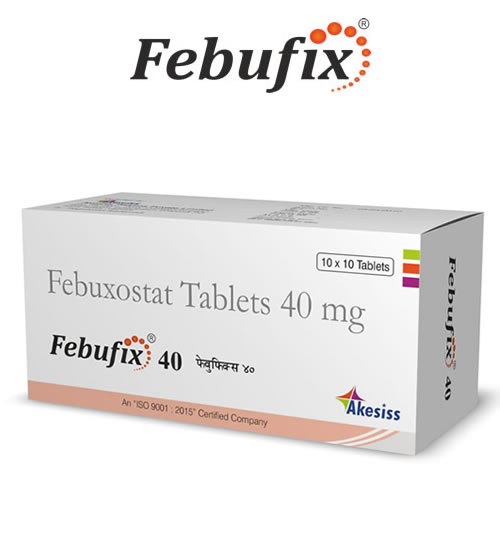COMPOSITION: Febuxostat−40 mg Tablet
Category: Xanthine oxidase inhibitor
SUMMARY:
Febuxostat is a xanthine oxidase inhibitor used for treating gout caused by excessive levels of uric acid in the blood (hyperuricemia). Uric acid is formed from the breakdown of certain chemicals (purines) in the body. Hyperuricemia occurs when the body produces more uric acid than it can eliminate. The uric acid forms crystals in joints (gouty arthritis) and tissues, causing inflammation and pain. Elevated blood uric acid levels also can cause kidney disease and kidney stones. The FDA approved febuxostat in February 2009.
Mechanism of Action:
Febuxostat is a nonpurine, selective inhibitor of xanthine oxidase/ xanthine dehydrogenase. The conversion of hypoxanthine to xanthine and uric acid is catalyzed by xanthine oxidase/xanthine dehydrogenase. Like allopurinol, febuxostat reduces serum uric acid levels through inhibition of this enzyme system, but febuxostat is more potent than allopurinol. Unlike allopurinol, febuxostat inhibits both the oxidized and reduced forms of xanthine oxidase and does not inhibit other enzymes involved in purine and pyrimidine metabolism.
Pharmacokinetics
Absorption: Febuxostat is administered orally and is quickly absorbed; it reaches its maximum plasma concentration in 1 to 1.5 hours after the dose is taken. Following oral absorption, approximately 85% of the drug is absorbed. Although the rate and extent of absorption may decrease with food intake and antacid use, no clinically significant change in the effect of febuxostat has been reported; therefore, it may be taken without regard to food or antacid consumption.
Distribution: There is no accumulation when it is given in therapeutic doses in daily intervals (once every 24 hours). It is approximately 99.2% protein-bound, primarily to albumin.
Metabolism: Febuxostat is metabolized primarily by uridinediphosphateglucuronosyl-transferase (UGT) enzymes by means of conjugation. A small portion also undergoes oxidation via cytochrome P (CYP) 450 isoenzymes. However, oxidation via CYP 450 is clinically insignificant in terms of the drug’s pharmacokinetics.
Elimination: Febuxostat is eliminated by both renal and hepatic pathways. However, renal clearance is not significant. Only a small amount of unchanged drug or metabolites is excreted in the urine.
Indication: Management of hyperuricemia in patients with gout.
Adverse Effects:
The adverse effects associated with febuxostat therapy include nausea, diarrhea, arthralgia, headache, increased hepatic serum enzyme levels and rash.
Contraindications:
Coadministration with azathioprine, mercaptopurine, or theophylline.
Warnings & Precautions:
Patients should be informed that an increase in gout flares is common after the commencement of febuxostat therapy. This is the result of the shift in urate from tissue deposits caused by the reduction in serum uric acid levels. To help avoid such flares, prophylactic treatment with an NSAID or colchicine is recommended when febuxostat is initiated. It may be beneficial to continue prophylactic therapy for up to six months. Febuxostat does not need to be discontinued if a flare occurs.


